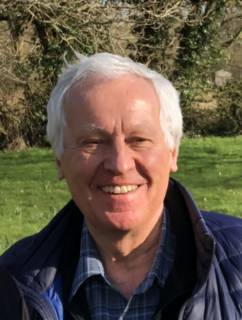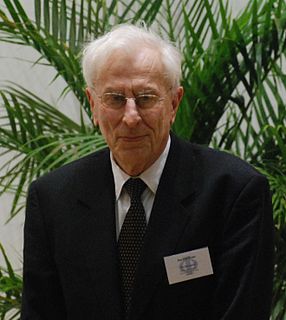Related Research Articles

In optics, chromatic aberration (CA), also called chromatic distortion and spherochromatism, is a failure of a lens to focus all colors to the same point. It is caused by dispersion: the refractive index of the lens elements varies with the wavelength of light. The refractive index of most transparent materials decreases with increasing wavelength. Since the focal length of a lens depends on the refractive index, this variation in refractive index affects focusing. Chromatic aberration manifests itself as "fringes" of color along boundaries that separate dark and bright parts of the image.
Fred Kavli was a Norwegian-American businessman and philanthropist. He was born on a small farm in Eresfjord, Norway. He founded the Kavlico Corporation, located in Moorpark, California. Under his leadership, the company became one of the world's largest suppliers of sensors for aeronautic, automotive, and industrial applications supplying General Electric and the Ford Motor Company.

The Molecular Foundry is a nanoscience user facility located at the Lawrence Berkeley National Laboratory in Berkeley, California, and is one of five Nanoscale Science Research Centers sponsored by the United States Department of Energy.

Sumio Iijima is a Japanese physicist and inventor, often cited as the inventor of carbon nanotubes. Although carbon nanotubes had been observed prior to his "invention", Iijima's 1991 paper generated unprecedented interest in the carbon nanostructures and has since fueled intense research in the area of nanotechnology.

Forschungszentrum Jülich is a national research institution that pursues interdisciplinary research in the fields of energy, information, and bioeconomy. It operates research infrastructures with a focus on supercomputers. Current research priorities include the structural change in the Rhineland lignite-mining region, hydrogen, and quantum technologies. As a member of the Helmholtz Association with roughly 6,800 employees in ten institutes and 80 subinstitutes, Jülich is one of the largest research institutions in Europe.

Transmission Electron Aberration-Corrected Microscope (TEAM) is a collaborative research project between four US laboratories and two companies. The project's main activity is design and application of a transmission electron microscope (TEM) with a spatial resolution below 0.05 nanometers, which is roughly half the size of an atom of hydrogen.

Harald Fuchs is a Professor of Experimental Physics at the University of Münster, Germany, Scientific Director of the Center of Nanotechnology (CeNTech) in Münster, and co-director of the Institute of Nanotechnology (INT) in Karlsruhe. His research focuses on nanoscale science and nanotechnology, ranging from scanning probe microscopy to self organized nanostructure fabrication, and nano–bio systems. He has published more than 450 scientific articles in various journals as an author or co-author. He was awarded the Philip Morris Research Prize "Challenge Future" in 1994 and the Münsterland Innovation Prize in 2001. He is currently member of the German Academy of Natural Scientists Leopoldina, the German "National Academy of Science and Engineering" as well as "The world academy of sciences". He holds two guest professorships in China. He is a cofounder of several nanotechnology companies and a member of the Editorial Boards in several international journals. In 2015 he received an Honorary Professorship at the Nanjing-Tech-University, China.

Sir John Brian Pendry, is an English theoretical physicist known for his research into refractive indices and creation of the first practical "Invisibility Cloak". He is a professor of theoretical solid state physics at Imperial College London where he was head of the department of physics (1998–2001) and principal of the faculty of physical sciences (2001–2002). He is an honorary fellow of Downing College, Cambridge, and an IEEE fellow. He received the Kavli Prize in Nanoscience "for transformative contributions to the field of nano-optics that have broken long-held beliefs about the limitations of the resolution limits of optical microscopy and imaging.", together with Stefan Hell, and Thomas Ebbesen, in 2014.

The Karlsruhe Institute of Technology is a public research university in the German state Baden-Württemberg and a national research center in the Helmholtz Association that is one of the largest educational institutions and the largest research institution by funding in Germany. KIT was created in 2009 when the University of Karlsruhe, founded in 1825 as a public research university and also known as the "Fridericiana", merged with the Karlsruhe Research Center, which had originally been established in 1956 as a national nuclear research center.

Gerd Binnig is a German physicist. He is most famous for having won the Nobel Prize in Physics jointly with Heinrich Rohrer in 1986 for the invention of the scanning tunneling microscope.

Otto Scherzer was a German theoretical physicist who made contributions to electron microscopy.

David J. Smith is a Regents' Professor of physics at Arizona State University. He is an Australian experimental physicist and his research is focussed on using the electron microscope to study the microstructure of different materials. He is a pioneer in high-resolution relectron microscopy technique and is very well known in his field. His interests are focused on thin films, nanostructures, novel materials and magnetism.
Louis E. Brus is the S. L. Mitchell Professor of Chemistry at Columbia University. He is the discoverer of the colloidal semi-conductor nanocrystals known as quantum dots.

Thomas Ebbesen is a Franco-Norwegian physical chemist and professor at the University of Strasbourg in France, known for his pioneering work in nanoscience. He received the Kavli Prize in Nanoscience “for transformative contributions to the field of nano-optics that have broken long-held beliefs about the limitations of the resolution limits of optical microscopy and imaging”, together with Stefan Hell, and Sir John Pendry in 2014.

Optical sectioning is the process by which a suitably designed microscope can produce clear images of focal planes deep within a thick sample. This is used to reduce the need for thin sectioning using instruments such as the microtome. Many different techniques for optical sectioning are used and several microscopy techniques are specifically designed to improve the quality of optical sectioning.
Knut W. Urban is a German physicist. He has been the Director of the Institute of Microstructure Research at Forschungszentrum Jülich from 1987 to 2010.

Ondrej L. Krivanek is a Czech/British physicist resident in the United States, and a leading developer of electron-optical instrumentation. He won the Kavli Prize for Nanoscience in 2020 for his substantial innovations in atomic resolution electron microscopy.

Harald Rose is a German physicist.

Andreas J. Heinrich is a physicist working with scanning tunneling microscopy, quantum technology, nanoscience, spin excitation spectroscopy, and precise atom manipulation. He worked for IBM Research in Almaden for 18 years, during which time he developed nanosecond scanning tunneling microscopy which provided an improvement in time resolution of 100,000 times, and combined x-ray absorption spectroscopy with spin excitation spectroscopy. In 2015 his team combined STM with electron spin resonance, which enables single-atom measurements on spins with nano-electronvolt precision REF1, REF2. In 2022 his team demonstrated the extension of ESR-STM to individual molecules REF3. Heinrich was also principal investigator of the stop-motion animated short film A Boy and His Atom filmed by moving thousands of individual atoms. He is a fellow of the American Physical Society and the American Association for the Advancement of Science and the recipient of the Heinrich Rohrer Medal of the Japan Society of Vacuum and Surface Science.
Peter David Nellist, is a British physicist and materials scientist, currently a professor in the Department of Materials at the University of Oxford. He is noted for pioneering new techniques in high-resolution electron microscopy.
References
- ↑ Jürgens, Michaela. "LEM – Mitarbeiter". KIT (in German). Retrieved 14 December 2021.
- ↑ "Dr. Max Haider". Corrected Electron Optical Systems (in German). Retrieved 14 December 2021.
- ↑ "KIT – KIT – Media – Press Releases – Archive Press Releases – Maximilian Haider Is Granted Wolf Prize for Physics". www.kit.edu. 16 April 2021. Retrieved 14 December 2021.
- ↑ "Innovation Award | Corrected Electron Optical Systems".
- ↑ Honda Prize Past Laureates
- ↑ "Congress in honour of Maximilian Haider and Harald Rose | Corrected Electron Optical Systems".
- ↑ "Archived copy". Archived from the original on 6 October 2015. Retrieved 11 August 2018.
{{cite web}}: CS1 maint: archived copy as title (link) - ↑ "Honorary Fellows". RMS. Retrieved 14 December 2021.
- ↑ NIMS Award
- ↑ 2020 Kavli Prize in Nanoscience, www.kavliprize.org. Retrieved 27 May 2020.